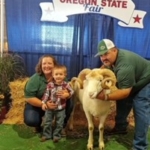Raising animals can provide environmental benefits and economic vitality to a piece of property. Goats, for example, can assist with brush management, provide manure that can be used as a soil amendment while also producing marketable milk and cheese. Raising livestock is also a means of diversifying an operation because it complements many other practices. But raising animals comes with varying characteristics that should be considered prior to getting started.
Stocking Rate
The stocking rate determines how many animals your land can support. It is this management practice that can have the greatest affect on the long-term condition of a site and the profitability of a livestock operation. Establishing the stocking rate, the amount of forage a particular animal needs, and how much forage is available, is key to maximizing profits while sustaining current land conditions. The stocking rate equation has been standardized for all animals based on weight.
Animal Feeding Operations (AFO’s)Feeding Operation
AFO’s and CAFO’s CAFO’s/AFO’s are defined by the EPA as “a place where animals are kept in a confined space for at least 45 days in a 12 month period, without any grass or vegetation being present during the normal growing season.” The difference between confined and other feeding operations is based in part by the number of animals that are involved. These operations congregate animals, feed, manure, urine, dead animals and a production facility on a small area of land. Feed is brought to the animals rather than allowing them to graze or feed in pastures or fields. Due to large concentrations of manure and the lack of ground vegetation these operations can cause great harm to the natural environment because of the risk of pollution during rain events. Implementing vegetation buffers along with a manure management strategy can help reduce the risk of polluted run-off or leachates.
Buying Animals
Conducting research prior to buying animals is always a good practice. There are many different breeds of each animal to choose from; be sure to choose the right breed for your land and what you are trying to accomplish. Buy animals from a trusted seller and try to avoid barn sales of culled animals. When buying animals ask the seller about problems with the herd and vaccination information to make sure there are no red flags. Be aware of the diseases and issues related to your particular animal and consult with the local veterinarian when problems occur.
Fencing
In Marion County there are currently no open range areas that allow animals to graze and roam freely; therefore fencing is required for containing animals on your property. There are numerous fencing types to choose from, each having pros and cons. Maintenance, upfront costs, the type of animals contained, durability, soil type, terrain, and effects on wildlife are some factors to think about when choosing the right fence. If you are constructing a new fence along a property line or roadway, contact Marion County Public Works to check for siting issues. Work with neighbors to develop the fence, to help establish a working relationship and to reduce the chance of future conflicts about the fence.
Selling Meat
In Oregon, selling meat from raised animals can be done in two ways. If you want to sell cuts of meat individually at farmers’ markets, to restaurants or grocery stores, the animal must be processed by a USDA certified plant. You can also sell the live animal to a customer; the purchaser is then responsibility for having it processed. This is known as an “on the hoof sell” and the meat from that sale cannot be sold, bartered or given to food banks.
Contact Us
Our planners can help you with all your livestock questions.

